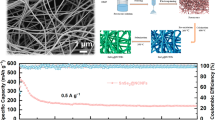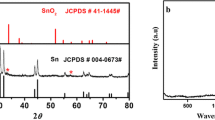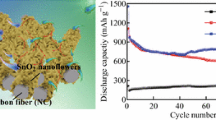Abstract
The effect of Sn/Ti ratio on the electrochemical properties of the anode is studied in Sn-doped TiO2 and SnO2–TiO2 nanofibers synthesized using a pilot-scale electrospinning system. Changes in the lattice structure of TiO2 due to the presence of Sn are studied through X-ray diffraction and high-resolution transmission electron microscopy. Lowering of electrochemical potential (vs Li/Li+) is observed alongside the enhanced capacity (400–600 mAh g−1) with increasing Sn content. Formation of SnO2 grain in sample with high Sn content (70 wt%) shows detrimental effect on cycling stability due to severe volume changes during lithiation/delithiation. We show that the relative fraction of TiO2 and SnO2 framework determines whether the composite is high capacity or high stability. In overall, SnO2–TiO2 composite anode with optimized Sn/Ti ratio can be used for high energy density, cycling stability and working potential lithium-ion battery.
Graphic abstract
The relative fraction of TiO2 and SnO2 framework determines whether the composite is high capacity or high stability






Similar content being viewed by others
Data availability
All data generated or analyzed during this study are included in this published article [and its supplementary information files].
References
K. Cao, T. Jin, L. Yang, L. Jiao, Recent progress in conversion reaction metal oxide anodes for Li-ion batteries. Mater. Chem. Front. 1(11), 2213–2242 (2017). https://doi.org/10.1039/C7QM00175D
J. Wang, T. Xu, X. Huang, H. Li, T. Ma, Recent progress of silicon composites as anode materials for secondary batteries. RSC Adv. 6(90), 87778–87790 (2016). https://doi.org/10.1039/C6RA08971B
S. Fang, D. Bresser, S. Passerini, Transition metal oxide anodes for electrochemical energy storage in lithium- and sodium-ion batteries. Adv. Energy Mater. 10(1), 1902485 (2020). https://doi.org/10.1002/aenm.201902485
Q. Liu et al., Recent progress of layered transition metal oxide cathodes for sodium-ion batteries. Small 15(32), 1805381 (2019). https://doi.org/10.1002/smll.201805381
A. Eftekhari, D.-W. Kim, Cathode materials for lithium–sulfur batteries: a practical perspective. J. Mater. Chem. A 5(34), 17734–17776 (2017). https://doi.org/10.1039/C7TA00799J
B. Writer, Anode materials, SEI, carbon, graphite, conductivity, graphene, reversible, formation, in Lithium-ion batteries: a machine-generated summary of current research. ed. by B. Writer (Springer, Cham, 2019), pp. 1–71
Z. Liu et al., Silicon oxides: a promising family of anode materials for lithium-ion batteries. Chem. Soc. Rev. 48(1), 285–309 (2019). https://doi.org/10.1039/C8CS00441B
Y. Jin, B. Zhu, Z. Lu, N. Liu, J. Zhu, Challenges and recent progress in the development of Si anodes for lithium-ion battery. Adv. Energy Mater. 7(23), 1700715 (2017). https://doi.org/10.1002/aenm.201700715
W. Qi, J.G. Shapter, Q. Wu, T. Yin, G. Gao, D. Cui, Nanostructured anode materials for lithium-ion batteries: principle, recent progress and future perspectives. J. Mater. Chem. A 5(37), 19521–19540 (2017). https://doi.org/10.1039/C7TA05283A
J. Lu, Z. Chen, F. Pan, Y. Cui, K. Amine, High-performance anode materials for rechargeable lithium-ion batteries. Electrochem. Energy Rev. 1(1), 35–53 (2018). https://doi.org/10.1007/s41918-018-0001-4
N. Pradeep, E. Sivasenthil, B. Janarthanan, S. Sharmila, A review of anode material for lithium ion batteries. J. Phys.: Conf. Ser. 1362, 012026 (2019). https://doi.org/10.1088/1742-6596/1362/1/012026
P. Roy, S.K. Srivastava, Nanostructured anode materials for lithium ion batteries. J. Mater. Chem. A 3(6), 2454–2484 (2015). https://doi.org/10.1039/C4TA04980B
L. Yin et al., Ultrafine SnO2 nanoparticles as a high performance anode material for lithium ion battery. Ceram. Int. 42(8), 9433–9437 (2016). https://doi.org/10.1016/j.ceramint.2016.02.173
Q. Tan et al., Synthesis of SnO2/graphene composite anode materials for lithium-ion batteries. Appl. Surf. Sci. 485, 314–322 (2019). https://doi.org/10.1016/j.apsusc.2019.04.225
F. Lin, H. Wang, Fe2O3–SnO2–graphene films as flexible and binder-free anode materials for lithium-ion batteries. J. Mater. Res. 30(18), 2736–2746 (2015). https://doi.org/10.1557/jmr.2015.265
R. Liu, N. Zhang, X. Wang, C. Yang, H. Cheng, H. Zhao, SnO2 nanoparticles anchored on graphene oxide as advanced anode materials for high-performance lithium-ion batteries. Front. Mater. Sci. 13(2), 186–192 (2019). https://doi.org/10.1007/s11706-019-0463-2
H. Yoo, G. Lee, J. Choi, Binder-free SnO2–TiO2 composite anode with high durability for lithium-ion batteries. RSC Adv. 9(12), 6589–6595 (2019). https://doi.org/10.1039/C8RA10358E
H.-Y. Wu, M.-H. Hon, C.-Y. Kuan, I.-C. Leu, Synthesis of TiO2(B)/SnO2 composite materials as an anode for lithium-ion batteries. Ceram. Int. 41(8), 9527–9533 (2015). https://doi.org/10.1016/j.ceramint.2015.04.011
J.A. Weeks et al., Facile synthesis of a tin oxide-carbon composite lithium-ion battery anode with high capacity retention. ACS Appl. Energy Mater. 2(10), 7244–7255 (2019). https://doi.org/10.1021/acsaem.9b01205
S. Gao et al., A multi-wall Sn/SnO2@carbon hollow nanofiber anode material for high-rate and long-life lithium-ion batteries. Angew. Chem. Int. Ed. 59(6), 2465–2472 (2020). https://doi.org/10.1002/anie.201913170
B. Pal et al., Hydrothermal syntheses of tungsten doped TiO2 and TiO2/WO3 composite using metal oxide precursors for charge storage applications. J. Alloys Compd. 740, 703–710 (2018). https://doi.org/10.1016/j.jallcom.2018.01.065
X. Zhu, S.S. Jan, F. Zan, Y. Wang, H. Xia, Hierarchically branched TiO2@SnO2 nanofibers as high performance anodes for lithium-ion batteries. Mater. Res. Bull. 96, 405–412 (2017). https://doi.org/10.1016/j.materresbull.2017.03.068
T. Tran, K. McCormac, J. Li, Z. Bi, J. Wu, Electrospun SnO2 and TiO2 composite nanofibers for lithium ion batteries. Electrochim. Acta 117, 68–75 (2014). https://doi.org/10.1016/j.electacta.2013.11.101
J.-H. Jeun et al., SnO2@TiO2 double-shell nanotubes for a lithium ion battery anode with excellent high rate cyclability. Nanoscale 5(18), 8480–8483 (2013). https://doi.org/10.1039/C3NR01964K
J.Y. Cheong, C. Kim, J.S. Jang, I.-D. Kim, Rational design of Sn-based multicomponent anodes for high performance lithium-ion batteries: SnO2@TiO2@reduced graphene oxide nanotubes. RSC Adv. 6(4), 2920–2925 (2016). https://doi.org/10.1039/C5RA23704A
Z. Yang, Q. Meng, Z. Guo, X. Yu, T. Guo, R. Zeng, Highly uniform TiO2/SnO2/carbon hybrid nanofibers with greatly enhanced lithium storage performance. J. Mater. Chem. A 1(35), 10395–10402 (2013). https://doi.org/10.1039/C3TA11751K
B. Pal, Z.H. Bakr, S.G. Krishnan, M.M. Yusoff, R. Jose, Large scale synthesis of 3D nanoflowers of SnO2/TiO2 composite via electrospinning with synergistic properties. Mater. Lett. 225, 117–121 (2018). https://doi.org/10.1016/j.matlet.2018.04.120
Z.H. Bakr, Q. Wali, J. Ismail, N.K. Elumalai, A. Uddin, R. Jose, Synergistic combination of electronic and electrical properties of SnO2 and TiO2 in a single SnO2–TiO2 composite nanofiber for dye-sensitized solar cells. Electrochim. Acta 263, 524–532 (2018). https://doi.org/10.1016/j.electacta.2018.01.074
J. Wang et al., Three-dimensional hierarchical Co3O4/CuO nanowire heterostructure arrays on nickel foam for high-performance lithium ion batteries. Nano Energy 6, 19–26 (2014). https://doi.org/10.1016/j.nanoen.2014.02.012
W. Guo, W. Sun, Y. Wang, Multilayer CuO@NiO hollow spheres: microwave-assisted metal–organic-framework derivation and highly reversible structure-matched stepwise lithium storage. ACS Nano 9(11), 11462–11471 (2015). https://doi.org/10.1021/acsnano.5b05610
C.-Y. Tsai, C.-W. Liu, C. Fan, H.-C. Hsi, T.-Y. Chang, Synthesis of a SnO2/TNT heterojunction nanocomposite as a high-performance photocatalyst. J. Phys. Chemistry C 121(11), 6050–6059 (2017). https://doi.org/10.1021/acs.jpcc.6b11005
D. Wang et al., Self-assembled TiO2–graphene hybrid nanostructures for enhanced Li-ion insertion. ACS Nano 3(4), 907–914 (2009). https://doi.org/10.1021/nn900150y
Y.S. Hu, L. Kienle, Y.G. Guo, J. Maier, High lithium electroactivity of nanometer-sized rutile TiO2. Adv. Mater. 18(11), 1421–1426 (2006). https://doi.org/10.1002/adma.200502723
M. Lee et al., The electrochemical performances of n-type extended lattice spaced Si negative electrodes for lithium-ion batteries. Front. Chem. (2019). https://doi.org/10.3389/fchem.2019.00389
D. Lau et al., Reduced silicon fragmentation in lithium ion battery anodes using electronic doping strategies. ACS Appl. Energy Mater. 3(2), 1730–1741 (2020). https://doi.org/10.1021/acsaem.9b02200
M. Chen et al., Boron-doped porous Si anode materials with high initial coulombic efficiency and long cycling stability. J. Mater. Chem. A 6(7), 3022–3027 (2018). https://doi.org/10.1039/C7TA10153H
Y. Domi, H. Usui, M. Shimizu, Y. Kakimoto, H. Sakaguchi, Effect of phosphorus-doping on electrochemical performance of silicon negative electrodes in lithium-ion batteries. ACS Appl. Mater. Interfaces 8(11), 7125–7132 (2016). https://doi.org/10.1021/acsami.6b00386
P. Goswami, J.N. Ganguli, Tuning the band gap of mesoporous Zr-doped TiO2 for effective degradation of pesticide quinalphos. Dalton Trans. 42(40), 14480–14490 (2013). https://doi.org/10.1039/C3DT51891D
Y. Hou et al., Oxygen vacancies promoting the electrocatalytic performance of CeO2 nanorods as cathode materials for Li–O2 batteries. J. Mater. Chem. A 7(11), 6552–6561 (2019). https://doi.org/10.1039/C9TA00882A
X. Zhai et al., Oxygen vacancy boosted the electrochemistry performance of Ti4+ doped Nb2O5 toward lithium ion battery. Appl. Surf. Sci. 499, 143905 (2020). https://doi.org/10.1016/j.apsusc.2019.143905
P. Zeng et al., Enhancement of electrochemical performance by the oxygen vacancies in hematite as anode material for lithium-ion batteries. Nanoscale Res. Lett. 12(1), 13 (2017). https://doi.org/10.1186/s11671-016-1783-0
J. Ahn, S. Yoon, S.G. Jung, J.-H. Yim, K.Y. Cho, A conductive thin layer on prepared positive electrodes by vapour reaction printing for high-performance lithium-ion batteries. J. Mater. Chem. A 5(40), 21214–21222 (2017). https://doi.org/10.1039/C7TA05591A
R. Zhao, J. Liu, J. Gu, The effects of electrode thickness on the electrochemical and thermal characteristics of lithium ion battery. Appl. Energy 139, 220–229 (2015). https://doi.org/10.1016/j.apenergy.2014.11.051
W. Bauer, D. Nötzel, V. Wenzel, H. Nirschl, Influence of dry mixing and distribution of conductive additives in cathodes for lithium ion batteries. J. Power Sources 288, 359–367 (2015). https://doi.org/10.1016/j.jpowsour.2015.04.081
L. Xue, X. Li, Y. Liao, L. Xing, M. Xu, W. Li, Effect of particle size on rate capability and cyclic stability of LiNi0.5Mn1.5O4 cathode for high-voltage lithium ion battery. J. Solid State Electrochem. 19(2), 569–576 (2015). https://doi.org/10.1007/s10008-014-2635-4
T. Liu et al., A high concentration electrolyte enables superior cycleability and rate capability for high voltage dual graphite battery. J. Power Sources 437, 226942 (2019). https://doi.org/10.1016/j.jpowsour.2019.226942
R. Tian et al., Quantifying the factors limiting rate performance in battery electrodes. Nat. Commun. 10(1), 1933 (2019). https://doi.org/10.1038/s41467-019-09792-9
L. Hu et al., Excellent cyclic and rate performances of SiO/C/graphite composites as li-ion battery anode. Front. Chem. (2020). https://doi.org/10.3389/fchem.2020.00388
A. Mahmoud, M. Chamas, P.-E. Lippens, Electrochemical impedance study of the solid electrolyte interphase in MnSn2 based anode for Li-ion batteries. Electrochim. Acta 184, 387–391 (2015). https://doi.org/10.1016/j.electacta.2015.10.078
R. Sen, P. Johari, Understanding the lithiation of the Sn anode for high-performance Li-ion batteries with exploration of novel Li–Sn compounds at ambient and moderately high pressure. ACS Appl. Mater. Interfaces 9(46), 40197–40206 (2017). https://doi.org/10.1021/acsami.7b11173
F. Xin, M.S. Whittingham, Challenges and development of tin-based anode with high volumetric capacity for Li-ion batteries. Electrochem. Energy Rev. 3(4), 643–655 (2020). https://doi.org/10.1007/s41918-020-00082-3
X. Zheng et al., A high capacity nanocrystalline Sn anode for lithium ion batteries from hydrogenation induced phase segregation of bulk YSn2. J. Mater. Chem. A 6(43), 21266–21273 (2018). https://doi.org/10.1039/C8TA07578F
J. Li et al., Phase evolution of conversion-type electrode for lithium ion batteries. Nat. Commun. 10(1), 2224 (2019). https://doi.org/10.1038/s41467-019-09931-2
Y. Abe, N. Hori, S. Kumagai, Electrochemical impedance spectroscopy on the performance degradation of LiFePO4/graphite lithium-ion battery due to charge-discharge cycling under different C-rates. Energies 12(23), 4507 (2019). https://doi.org/10.3390/en12234507
M.V. Reddy, G. Prithvi, K.P. Loh, B.V.R. Chowdari, Li storage and impedance spectroscopy studies on Co3O4, CoO, and CoN for Li-ion batteries. ACS Appl. Mater. Interfaces 6(1), 680–690 (2014). https://doi.org/10.1021/am4047552
M.V. Reddy, R. Jose, T.H. Teng, B.V.R. Chowdari, S. Ramakrishna, Preparation and electrochemical studies of electrospun TiO2 nanofibers and molten salt method nanoparticles. Electrochim. Acta 55(9), 3109–3117 (2010). https://doi.org/10.1016/j.electacta.2009.12.095
M.V. Reddy, G.V. Subba Rao, B.V.R. Chowdari, Nano-(V1/2Sb1/2Sn)O4: a high capacity, high rate anode material for Li-ion batteries. J. Mater. Chem. 21(27), 10003–10011 (2011). https://doi.org/10.1039/C0JM04140H
Acknowledgments
This work is funded by the Fundamental Research Grant Scheme of the Ministry of Education, Govt. of Malaysia through FRGS/1/2019/STG07/UMP/01/1. Ling JK acknowledges the financial support from Post-graduate Research Scheme (PGRS) by Universiti Malaysia Pahang (http://www.ump.edu.my) through UMP.05.02/26.10/03/03/PGRS2003123. The authors would like to express gratitude to Battery Research Centre of Green Energy (BRCGE) of Ming Chi University of Technology, New Taipei City, Taiwan, R.O.C. (https://www.mcut.edu.tw/) and Taiwan Experience Education Program (TEEP@AsiaPlus) for their research financial support.
Author information
Authors and Affiliations
Corresponding author
Ethics declarations
Conflict of interest
The authors declare that they have no known competing financial interests or personal relationships that could have appeared to influence the work reported in this paper.
Supplementary Information
Below is the link to the electronic supplementary material.
Rights and permissions
About this article
Cite this article
Ling, J., Karuppiah, C., Reddy, M.V. et al. Unraveling synergistic mixing of SnO2–TiO2 composite as anode for Li-ion battery and their electrochemical properties. Journal of Materials Research 36, 4120–4130 (2021). https://doi.org/10.1557/s43578-021-00313-3
Received:
Accepted:
Published:
Issue Date:
DOI: https://doi.org/10.1557/s43578-021-00313-3




